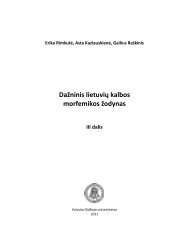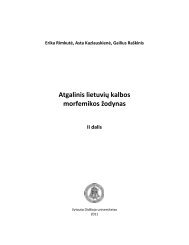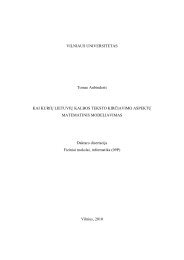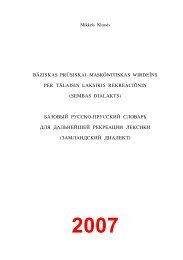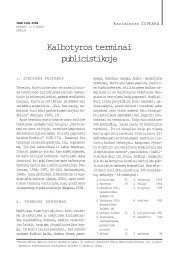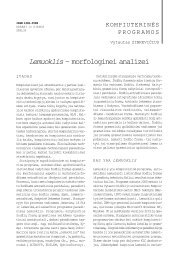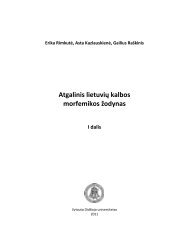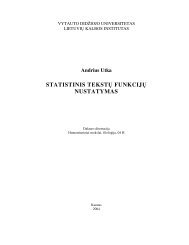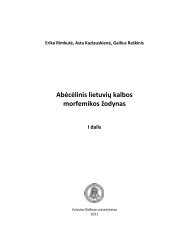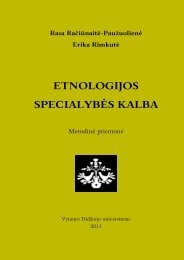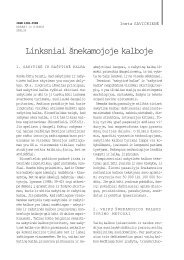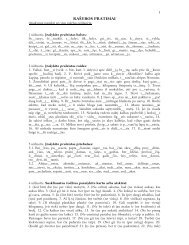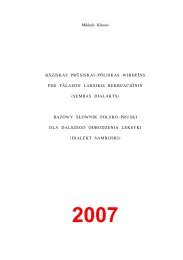HISTORICAL GRAMMAR OF OLD PRUSSIAN
HISTORICAL GRAMMAR OF OLD PRUSSIAN
HISTORICAL GRAMMAR OF OLD PRUSSIAN
You also want an ePaper? Increase the reach of your titles
YUMPU automatically turns print PDFs into web optimized ePapers that Google loves.
<strong>HISTORICAL</strong> <strong>GRAMMAR</strong> <strong>OF</strong> <strong>OLD</strong> <strong>PRUSSIAN</strong><br />
*stas-. In addition, when inquiring into the origin of Pr. -es- (stesse<br />
etc.), one should not ignore the segment -es- in OSlav. gen. èeso ‘what’ 72 .<br />
Note: forms sg. steises, steismu, etc. got their -ei- from the genitive<br />
plural (cf. Endzelîns l. c.). With all probability this -ei- indirectly confirms<br />
oldness of Pr. -es- (stesse etc.).<br />
* 163. Dat. sg. masc. stesmu ends in -u < (oxytone-stems) accented<br />
dat. sg. *-ô < Balt. *-ô (Rosinas BÁM 85). Pr. (Cat.) stesmu (stesma)<br />
< WBalt. *tesmô Lith. tuõ) in expression stu ilgimi ‘so long as’. In another expression,<br />
ste mijls ‘the more willingly’, the word ste = Pr. *stç shows that there<br />
existed an alternant instr. sg. *tç beside *tô in Baltic 73 .<br />
72 Some comparative-historical ruse is necessay to ground the reconstruction stesse < *tesja<br />
(*tesje), e.g. either *tesja > *teƒsja > *teðe --> *tese (similarly Endzelîns l. c.), or *tesja ><br />
*tesje > *tese. In any case the transition *sÙa > *sÙe (usually speaking – Baltic-Slavic *TÙ` ><br />
*TÙç, cf. ftn. 53) is hardly imaginable on Prussian level: Pr. gen. masc. *tesja- and gen. fem.<br />
*tesj`- should have turned into masc. oteða-, fem. oteð`- respectively, not into *tese-, *tesç- (?).<br />
(Not to mix up with spellings -sia- = -sie-, which reflect neutralization of phonems /a/ : /e/, in<br />
Samlandian of the Catechisms! This dialect had nothing to do with Baltic *tes-).<br />
Quite convincible, simple and sufficient explanation of the origin of Pr. stesse is given by<br />
Maþiulis BS 93 ff.: 1) Pr. gen. sg. masc. subst. *-as and pron. *-es- are of the same IE origin<br />
with apophonic Balt. *a /*e (IE *o /*e), e.g. Pr. (deiw)-as = Hit. (eð©h)-að = Go. (wulf)-is < *-es-<br />
= Pr. (st)-ess-e = OSl. (è)-es-o; 2) difference in final vowel between Pr. (stess)-e and OSl. (èes)o<br />
is also apophonic. Palmaitis BGR 47–54, 82 explains this final vowel as relic of Proto-IE<br />
vocalisation of the inflection -s < deictic *-so/e, cf. IE pronoun OInd. nom. s³, Gk. ¿, Go. sa.<br />
– L.P.<br />
73 This contradicts to Maþiulis BS, which is a theory of Baltic (and Indoeuropean) declension.<br />
Contrarily to tradition, BS shows that Indoeuropean “secondary cases”, especially locative and<br />
instrumental, were formed in different IE dialects by different paradigmatizing of often the same<br />
adverbial stems (not the adverbs might be relics of “Common-IE” cases which as if differently<br />
vanished in various groups due to “syncretism”). Thus Greek appears to have had 4-cases paradigms<br />
from the very beginning. Of course, Prussian instrumental may be discussed in frames of<br />
BS. However dative, instrumental and locative alternants (the same form often appearing in different<br />
cases) even in Lithuanian dialects make their paradigmatic (not adverbial) provenance<br />
impossible. BS does not allow to reconstruct 6-cases paradigms neither in Common Indoeuropean<br />
(7-cases), nor in Common Baltic. To speak about “Baltic instrumental”, whether in 2 forms,<br />
means to assume paradigmatic instrumental, locative, etc. in Baltic. Cf. also ftn. 37. – L.P.<br />
71



